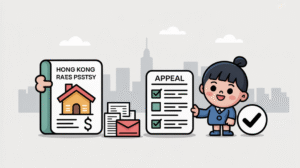How to Budget for Property Rates When Expanding Your Business to Hong Kong
📋 Key Facts at a Glance
- Standard Property Rates: 5% of rateable value annually
- Government Rent: 3% of rateable value annually (applies to most properties)
- Total Annual Liability: Typically 8% of rateable value per year
- Payment Frequency: Quarterly (end of January, April, July, October)
- 2024-25 Concession: HK$1,000 for Q1 only
- 2025-26 Concession: HK$500 for Q1 only
- Late Payment Penalty: 5% surcharge immediately, additional 10% after 6 months
- Commercial Leases: Rates typically passed through to tenants
- Liability Start Date: Rates apply from occupation date (even during fit-out)
- Budget Rule of Thumb: Estimate rates at ~8% of annual rent budget
Expanding your business to Hong Kong presents exciting opportunities, but have you accounted for one of the most overlooked operational costs? Property rates in Hong Kong aren’t just another line item—they’re a predictable yet significant expense that can make or break your expansion budget. Unlike many jurisdictions with bundled property taxes, Hong Kong’s dual system of rates and government rent requires specific understanding to avoid costly surprises. This comprehensive guide provides fact-checked, actionable information to help you accurately budget for property rates when establishing your business presence in Asia’s world city.
Understanding Hong Kong’s Property Rate System
What Exactly Are Property Rates?
Property rates in Hong Kong are a form of property tax levied by the Rating and Valuation Department (RVD) based on a property’s rateable value. This value represents the estimated annual rental value at a designated valuation reference date, determined by analyzing comparable market rents in the same area. Think of it as the government’s assessment of what your property should rent for in the open market.
The Two-Part System: Rates + Government Rent
Most commercial properties in Hong Kong face two separate charges that together form your total property tax liability:
- Property Rates: Set at 5% of rateable value annually, funding municipal services like street cleaning, lighting, and drainage
- Government Rent: Set at 3% of rateable value annually, applying to properties under leases executed after June 30, 1997, or extended after that date
How Rateable Value is Determined
The RVD assesses rateable values based on open market rental values of comparable properties in the same locality. The department conducts general revaluations periodically to reflect current market conditions. Key factors include:
- Location and accessibility to transportation
- Size, layout, and usable floor area
- Age, condition, and building quality
- Facilities, amenities, and building services
- Current market rental rates for similar properties
10-Step Budgeting Checklist for Property Rates
- Research Target Properties: Identify potential office, retail, or warehouse spaces that meet your business needs. Create a shortlist with addresses and approximate rental costs.
- Check Rateable Values via RVD Website: Visit the Rating and Valuation Department’s online portal (www.rvd.gov.hk) for free rateable value lookup. Search by specific address to obtain exact current values for each property.
- Calculate Annual Rates Liability: Multiply the rateable value by 8% to determine total annual rates and government rent liability (5% rates + 3% government rent).
- Factor in Current Concessions: Deduct applicable rate concessions for the first quarter. For 2024-25: HK$1,000 Q1 concession; for 2025-26: HK$500 Q1 concession.
- Determine Quarterly Payment Amounts: Divide the annual liability by 4 to calculate quarterly payments. Adjust Q1 payment for any concessions. Note payment deadlines: end of January, April, July, and October.
- Review Lease Agreement Terms: Confirm that the lease passes rates responsibility to the tenant (standard in commercial leases). Verify whether any portion is included in rent or payable separately.
- Compare Total Occupancy Costs: Add rates to base rent, management fees, air conditioning charges, and other costs to compare true total occupancy cost across different properties.
- Account for Occupation Date: Remember that rates apply from your occupation date, even during fit-out or renovation periods. Budget for rates from the day you take possession.
- Set Up Payment System: Establish autopay arrangements to avoid late payment penalties (5% immediately, additional 10% after 6 months). Ensure your finance team has payment deadlines in their calendar.
- Build Contingency Buffer: Include a 5-10% contingency in your property rates budget to account for potential rateable value increases during general revaluations.
Quarterly Payment Schedule and Deadlines
Property rates and government rent are payable quarterly in advance. Understanding this schedule is crucial for cash flow planning:
| Quarter | Period Covered | Payment Deadline | Notes |
|---|---|---|---|
| Q1 | January 1 – March 31 | End of January | Concessions typically apply to Q1 only |
| Q2 | April 1 – June 30 | End of April | Full amount (no concessions) |
| Q3 | July 1 – September 30 | End of July | Full amount (no concessions) |
| Q4 | October 1 – December 31 | End of October | Full amount (no concessions) |
Practical Budgeting Examples by Business Type
Example 1: Startup Tech Company (Small Office)
Business Profile: Office space in Grade B building, Kwun Tong | 2,000 sq ft | Market Rent: HK$24,000/month | Rateable Value: HK$285,000
| Component | Calculation | Amount |
|---|---|---|
| Property Rates (5%) | HK$285,000 × 5% | HK$14,250 |
| Government Rent (3%) | HK$285,000 × 3% | HK$8,550 |
| Total Annual Liability | HK$285,000 × 8% | HK$22,800 |
Budget Summary: Monthly occupancy cost: HK$24,000 (rent) + HK$1,817 (rates averaged) = HK$25,817/month
Budget Tip: Set aside HK$5,700/quarter or approximately HK$1,900/month for rates payments.
Example 2: Retail Store (Street-Level Shop)
Business Profile: Ground floor retail shop, Causeway Bay | 800 sq ft | Market Rent: HK$160,000/month | Rateable Value: HK$1,850,000
| Component | Calculation | Amount |
|---|---|---|
| Property Rates (5%) | HK$1,850,000 × 5% | HK$92,500 |
| Government Rent (3%) | HK$1,850,000 × 3% | HK$55,500 |
| Total Annual Liability | HK$1,850,000 × 8% | HK$148,000 |
Budget Summary: Monthly occupancy cost: HK$160,000 (rent) + HK$12,333 (rates averaged) = HK$172,333/month
Budget Tip: Rates represent 7.7% of total rent costs. Set aside HK$37,000/quarter for rates payments.
Quick Reference: Rates Calculation by Rateable Value
| Rateable Value | Annual Rates (5%) | Annual Gov’t Rent (3%) | Total Annual Liability (8%) | Quarterly Payment |
|---|---|---|---|---|
| HK$200,000 | HK$10,000 | HK$6,000 | HK$16,000 | HK$4,000 |
| HK$500,000 | HK$25,000 | HK$15,000 | HK$40,000 | HK$10,000 |
| HK$1,000,000 | HK$50,000 | HK$30,000 | HK$80,000 | HK$20,000 |
| HK$2,000,000 | HK$100,000 | HK$60,000 | HK$160,000 | HK$40,000 |
| HK$3,000,000 | HK$150,000 | HK$90,000 | HK$240,000 | HK$60,000 |
| HK$5,000,000 | HK$250,000 | HK$150,000 | HK$400,000 | HK$100,000 |
Critical Budgeting Considerations
1. Commercial Leases Pass Rates to Tenants
In Hong Kong, it’s standard practice for commercial leases to pass the responsibility for paying property rates and government rent to the tenant. When reviewing lease agreements:
- Verify explicitly that rates are the tenant’s responsibility
- Confirm whether rates are payable directly to the government or reimbursed to the landlord
- Check if any portion of rates is included in the quoted rent (uncommon but possible)
- Understand who receives the demand notes and is responsible for timely payment
2. Rates Apply from Occupation Date
A critical point often missed by new businesses: rates liability begins from your occupation date, not your business opening date. This means:
- Rates are payable during fit-out and renovation periods
- You’re liable from the day you take possession, even if not generating revenue
- Budget for 1-3 months of rates during your setup period before opening
- Factor this into your cash flow projections for the pre-revenue period
3. Verify Actual Rateable Value Before Signing
Never rely solely on landlord estimates or real estate agent approximations. Always verify the actual rateable value through the RVD’s official online portal before committing to a lease:
- Visit www.rvd.gov.hk for free rateable value lookups
- Search by specific address to get the exact current rateable value
- Compare rateable values between similar properties in your shortlist
- Note that rateable value may differ significantly from actual market rent
4. Rate Concessions Vary Year to Year
The Hong Kong government announces rate concessions annually as part of the budget. These concessions typically apply only to the first quarter:
- 2024-25: HK$1,000 concession for Q1 only
- 2025-26: HK$500 concession for Q1 only
- Concessions are subject to change and should not be assumed for future years
- Budget conservatively using full rates amounts; treat concessions as a bonus
Common Budgeting Mistakes to Avoid
Many international businesses assume quoted rental prices include all occupancy costs. In Hong Kong, rates are almost always separate from rent in commercial leases. Always confirm and budget for rates as an additional expense.
While rateable value is based on market rent, it may not equal your actual rent. Properties with below-market or above-market rents will have rateable values that differ from actual rent paid. Always check the official rateable value.
Some budgets only account for the 5% property rates and miss the additional 3% government rent. The total typical liability is 8% of rateable value, not 5%. Don’t underbudget by 37.5%!
Rates apply from occupation, not from your business opening. If you need 2 months for fit-out, budget for 2 months of rates before revenue begins. This can be a significant cash flow item for new businesses.
Rate concessions vary annually and are political decisions announced with each budget. While recent years have seen Q1 concessions, these should not be assumed for future years. Budget conservatively using full rates amounts.
Tools and Resources for Rate Budgeting
Official Resources
- Rating and Valuation Department (RVD) Website: www.rvd.gov.hk – Free rateable value lookup, demand note information, payment options
- RVD Customer Service: Phone inquiries for specific questions about your rateable value or liability
- RVD Mobile App: Available for checking rateable values and making payments on the go
- E-Services Portal: Online platform for setting up autopay and managing payments
Payment Methods
- Autopay (Recommended): Set up through your bank to ensure timely payments and avoid penalties
- Online Payment: Via RVD website using credit card or e-banking
- PPS (Phone/Internet): Payment by Phone Service or Internet banking
- Bank Counter: In-person payment at designated banks
- Convenience Stores: 7-Eleven and Circle K accept rates payments (subject to limits)
✅ Key Takeaways
- Budget the 8% Rule: Property rates and government rent typically total 8% of rateable value annually (5% + 3%). Use this as your baseline calculation.
- Verify Before You Sign: Always check the actual rateable value via the RVD website before committing to any lease. Don’t rely on estimates from landlords or agents.
- Rates ≠ Rent: Rateable value may differ from your actual rent. Always look up the specific property’s official rateable value to calculate accurate rates costs.
- Plan for Quarterly Payments: Rates are payable quarterly at the end of January, April, July, and October. Set aside funds monthly to avoid cash flow shocks.
- Liability Starts on Occupation: You’re liable for rates from the day you take possession, including during fit-out periods before opening. Budget accordingly.
- Set Up Autopay: Late payment penalties are severe (5% immediately, 10% more after 6 months). Autopay eliminates this risk entirely.
- Commercial Leases Pass Rates to Tenants: It’s standard practice in Hong Kong for tenants to pay property rates. Verify this is clearly stated in your lease.
- Compare Total Occupancy Costs: When evaluating properties, compare rent + rates + management fees + utilities to determine true total cost. Lower rent doesn’t always mean lower total cost.
- Concessions Are Temporary: Annual rate concessions (currently HK$500-1,000 in Q1) vary year to year. Budget conservatively using full rates amounts.
- Build in Contingency: Include a 5-10% buffer in your rates budget to account for potential rateable value increases during general revaluations.


